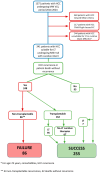Laparoscopic Microwave Ablation and Salvage Liver Transplantation in Patients with Hepatocellular Carcinoma
- PMID: 40647548
- PMCID: PMC12249359
- DOI: 10.3390/cancers17132248
Laparoscopic Microwave Ablation and Salvage Liver Transplantation in Patients with Hepatocellular Carcinoma
Abstract
Background/Objectives: Salvage liver transplantation (SLT) is a well-established option for hepatocellular carcinoma (HCC) recurrence after liver resection. Laparoscopic microwave ablation (L-MWA) represents another curative strategy for early-stage HCC. However, its role within this therapeutic framework remains unexplored. Methods: Between 2014 and 2023, we treated 1341 patients with HCC using L-MWA. From this cohort, patients with Child-Pugh class A liver function, HCC within the Milan criteria, no contraindications to transplantation, and ≥12 months of follow-up were selected. SLT failure was defined as non-transplantable recurrence or death, resulting in the loss of a potentially curative therapeutic opportunity. The primary endpoint was overall survival (OS); secondary endpoints included predictors of survival and SLT failure. Results: A total of 341 patients met the inclusion criteria. Five-year OS was 62%. Independent predictors of poorer survival included the presence of cardiac disease or oesophageal varices, a Child-Pugh score of 6, tumour size, and elevated alpha-fetoprotein (AFP) levels. Treatment was successful in 255 patients (74.8%): 102 (29.9%) underwent SLT, 67 (19.6%) received alternative therapies, and 93 (27.3%) remained recurrence-free. Treatment failure occurred in 86 patients (25.2%) due to non-transplantable recurrence or death. Independent predictors of failure included older age, non-HBV aetiology, and elevated AFP levels. Five-year OS rates were 79% in the success group and 22% in the failure group (p < 0.001). Conclusions: A combined L-MWA and SLT strategy is safe and effective, yielding a 62% 5-year OS rate. This approach supports more efficient graft use with a consequent increase in the population transplant benefit. Improved selection may further reduce failure rates.
Keywords: graft shortage; hcc recurrence; hepatocellular carcinoma; laparoscopic microwave ablation; salvage liver transplantation.
Conflict of interest statement
A.V. has received consulting fees from AstraZeneca and Roche. The other authors declare no conflicts of interest.
Figures



References
-
- Halazun K.J., Quillin R.C., Rosenblatt R., Bongu A., Griesemer A.D., Kato T., Smith C., Michelassi F., Guarrera J.V., Samstein B., et al. Expanding the Margins: High Volume Utilization of Marginal Liver Grafts among >2000 Liver Transplants at a Single Institution. Ann. Surg. 2017;266:441–449. doi: 10.1097/SLA.0000000000002383. - DOI - PubMed
-
- Mazzaferro V., Citterio D., Bhoori S., Bongini M., Miceli R., De Carlis L., Colledan M., Salizzoni M., Romagnoli R., Antonelli B., et al. Liver Transplantation in Hepatocellular Carcinoma after Tumour Downstaging (XXL): A Randomised, Controlled, Phase 2b/3 Trial. Lancet Oncol. 2020;21:947–956. doi: 10.1016/S1470-2045(20)30224-2. - DOI - PubMed
-
- Xu E., Tabrizian P., Gutierrez J., Hoteit M., Ghaziani T., Zhou K., Parikh N., Ajmera V., Aby E., Shui A., et al. Downstaging of Hepatocellular Carcinoma before Liver Transplantation: Results from a National Multi-Center Prospective Cohort Study. Hepatology. 2025;ahead of print doi: 10.1097/HEP.0000000000001231. - DOI - PMC - PubMed
-
- Sapisochin G., Barry A., Doherty M., Fischer S., Goldaracena N., Rosales R., Russo M., Beecroft R., Ghanekar A., Bhat M., et al. Stereotactic Body Radiotherapy vs. TACE or RFA as a Bridge to Transplant in Patients with Hepatocellular Carcinoma. An Intention-to-Treat Analysis. J. Hepatol. 2017;67:92–99. doi: 10.1016/j.jhep.2017.02.022. - DOI - PubMed
LinkOut - more resources
Full Text Sources
Miscellaneous

